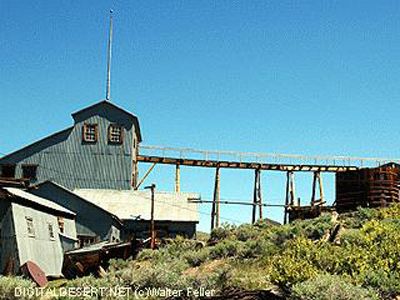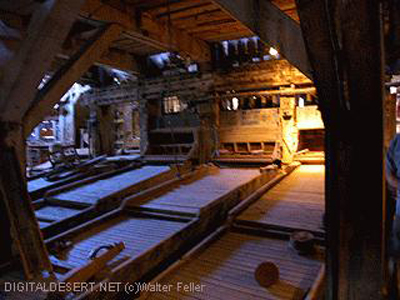Bodie, an Exception
Bodie, one of the premier gold mines in the region, was an exception to predominance of silver mining during the 1870s and 1880s. Rich gold was discovered in the underground workings in 1872, reviving the mine. By 1888 more than $18 million was produced. The gold mines of the Cargo Muchacho Mountains and at Picacho in Imperial County were also exceptions. In 1877, with the arrival of the Southern Pacific Railroad in the area, the mines here began to be worked.Gold reigned as king with the loss of silver price supports in 1893. As if on cue, several important gold deposits were discovered. These included Vanderbilt (1893), Red Rock Canyon (1894), the Summit Diggings (1894), the Yellow Aster Mine (1895), the Mojave Mining District (1894), the Ratcliffe Mine in the Panamint Range (1897) and the Bagdad-Chase Mine (1901). Mining revived at Picacho, in the Cargo Muchacho Mountains, and many other older districts.
In June 1903 a standard gauge railroad, the Ludlow and Southern, was completed from Ludlow to the Bagdad-Chase Mine. Ore was shipped to the Randsburg-Santa Fe Reduction Company’s 50-stamp mill at Barstow for processing. This mine was to become one of the premier producers in the entire desert. The Yellow Aster Mine at Randsburg was another major producer. In November 1897 the 28 mile long Randsburg Railroad was constructed north from Kramer on the Santa Fe to Johannesburg near the mines.
In addition to economic considerations that favored gold, there were several technical innovations. Foremost was the introduction of cyanide to recover gold. In 1890 John MacArthur and Robert and William Forrest of Glasgow, Scotland introduced the cyanide process to the Witwatersrand gold mines in South Africa. The process was found to extract 96 percent of gold from the ore. This enabled recovery rates unimagined with mercury amalgamation alone. The use of cyanide breathed new life into many older gold districts. Bodie, whose production by then had slumped, became one of the first mines in the United States to utilize cyanide. Soon its use became the industry standard. Also, men with portable cyanide plants reworked old mill tailings.
After the Southern Pacific Railroad reached Mojave in 1875, the line was pushed into Los Angeles, then south through the Coachella Valley. In May 1877, the line crossed the Colorado River at Yuma. The railroad had an immediate impact on the mining industry. Silver-lead ore was hauled from Darwin, Lookout, and Panamint City to the new railhead at Mojave. Borax ore, which had been shipped from Searles Lake to San Pedro since 1873, was now only hauled 80 miles. Beginning in the winter of 1882, and continuing for the next six years, William Coleman hauled borax from the Harmony Borax Works in Death Valley to Mojave in the world-famous “twenty-mule teams.” The Bonanza King Mine located far out in the east Mojave Desert had its mill delivered in July 1882 from Mojave.
Previous - Next

American Standard Mill - Bodie

American Standard Mill - Bodie